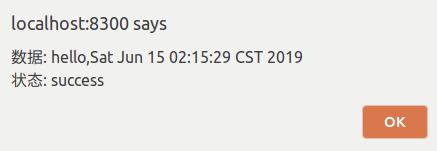SpringBoot解决跨域请求拦截
前言
同源策略:判断是否是同源的,主要看这三点,协议,ip,端口。
同源策略就是浏览器出于网站安全性的考虑,限制不同源之间的资源相互访问的一种政策。
比如在域名https://www.baidu.com下,脚本不能够访问https://www.sina.com源下的资源,否则将会被浏览器拦截。
注意两点:
1.必须是脚本请求,比如AJAX请求。
但是如下情况不会产生跨域拦截
<img src="xxx"/> <a href='xxx"> </a>
2.跨域拦截是前端请求已经发出,并且在后端返回响应时检查相关参数,是否允许接收后端请求。
在微服务开发中,一个系统包含多个微服务,会存在跨域请求的场景。
本文主要讲解SpringBoot解决跨域请求拦截的问题。
搭建项目
这里创建两个web项目,web1 和 web2.
web2项目请求web1项目的资源。
这里只贴关键代码,完整代码参考GitHub
WEB2
创建一个Controller返回html页面
@Slf4j
@Controller
public class HomeController {
@RequestMapping("/index")
public String home(){
log.info("/index");
return "/home";
}
}
html页面 home.html
这里创建了一个按钮,按钮按下则请求资源:"http://localhost:8301/hello"
<!DOCTYPE html>
<html lang="en">
<head>
<meta charset="UTF-8">
<title>web2</title>
<script src="https://cdn.staticfile.org/jquery/1.10.2/jquery.min.js">
</script>
<script>
$(function () {
$("#testBtn").click(function () {
console.log("testbtn ...");
$.get("http://localhost:8301/hello",function(data,status){
alert("数据: " + data + "\n状态: " + status);
});
})
})
</script>
</head>
<body>
web2
<button id="testBtn">测试</button>
</body>
</html>
WEB1
@Slf4j
@RestController
public class Web1Controller {
@RequestMapping("/hello")
public String hello(){
log.info("hello ");
return "hello," + new Date().toString();
}
}
这里配置两个项目为不同的端口。
WEB1为8301
WEB2为8302
因此是不同源的。
测试
在web1还没有配置允许跨域访问的情况下
按下按钮,将会出现错误。显示Header中没有Access-Control-Allow-Origin
Access to XMLHttpRequest at 'http://localhost:8301/hello' from origin 'http://localhost:8300' has been blocked by CORS policy: No 'Access-Control-Allow-Origin' header is present on the requested resource.
WEB1添加允许跨域请求,通过实现WebMvcConfigurer
@Configuration
public class WebMvcConfig implements WebMvcConfigurer {
@Override
public void addCorsMappings(CorsRegistry registry) {
registry.addMapping("/hello");
}
}
再次访问将会返回正常数据。

除了以上的配置外,还可以做更细致的限制
比如对请求的headers,请求的方法POST/GET...。请求的源进行限制。

同时还可以使用注解 @CrossOrigin来替换上面的配置。
@Slf4j
@RestController
public class Web1Controller {
@CrossOrigin
@RequestMapping("/hello")
public String hello(){
log.info("hello ");
return "hello," + new Date().toString();
}
}
注解可以用在类上,也可以用在方法上,但必须是控制器类
配置和上面一样,也是可以对方法,header,源进行个性化限制。
@Target({ElementType.METHOD, ElementType.TYPE})
@Retention(RetentionPolicy.RUNTIME)
@Documented
public @interface CrossOrigin {
/** @deprecated */
@Deprecated
String[] DEFAULT_ORIGINS = new String[]{"*"};
/** @deprecated */
@Deprecated
String[] DEFAULT_ALLOWED_HEADERS = new String[]{"*"};
/** @deprecated */
@Deprecated
boolean DEFAULT_ALLOW_CREDENTIALS = false;
/** @deprecated */
@Deprecated
long DEFAULT_MAX_AGE = 1800L;
@AliasFor("origins")
String[] value() default {};
@AliasFor("value")
String[] origins() default {};
String[] allowedHeaders() default {};
String[] exposedHeaders() default {};
RequestMethod[] methods() default {};
String allowCredentials() default "";
long maxAge() default -1L;
}
- SpringBoot使用CORS解决跨域请求问题
- 用反向代理nginx proxy_pass配置解决ie8 ajax请求被拦截问题 ie8用nginx代理实现跨域请求访问 nginx405正向代理request_uri
- springboot解决跨域请求问题
- 基于 HTTP 请求拦截,快速解决跨域和代理 Mock
- js利用jquery的jsonp来解决ajax跨域请求被浏览器拦截结果的问题
- 利用Access-Control-Allow-Origin响应头解决跨域请求
- 跨域请求的解决方法(JSONP, CORS)
- SpringBoot解决跨域的问题
- JSONP跨域请求数据报错 “Unexpected token :”的解决办法
- 跨域请求,关于后端session会话丢失的解决办法
- Ajax 跨域请求 配置解决方法 tomcat weblogic适用
- 解决ajax跨域请求 (总结)
- JSONP跨域请求数据报错 “Unexpected token :”的解决办法
- JSONP跨域请求数据报错 “Unexpected token :”的解决办法
- ajax请求解决跨域问题 摒弃jsonp方式
- 解决同域Nginx ajax 请求跨域的问题
- springboot 解决跨域问题(options)
- vue使用代理解决请求跨域问题
- 解决tomcat服务器跨域请求问题
- 使用jsonp解决ajax请求json跨域问题
